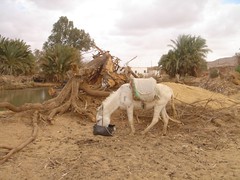An aquifer is an underground layer of water-bearing permeable rock or unconsolidated materials (gravel, sand, silt, or clay) from which groundwater can be usefully extracted using a water well. The study of water flow in aquifers and the characterization of aquifers is called hydrogeology, says wikipedia.
Aquifers can occur at various depths.
Those closer to the surface are more likely to be exploited for water supply and irrigation; they are also more likely to be topped up by the local rainfall.
Many desert areas have limestone hills or mountains within them or close to them which can be exploited as groundwater resources. Parts of the Atlas Mountains in North Africa, the Lebanon and Anti-Lebanon ranges of Syria, Israel and Lebanon, the Djebel Akhdar in Oman, parts of the Sierra Nevada and neighbouring ranges in the United State's South West, have shallow aquifers which are exploited for their water.
Over exploitation can lead to the exceeding of the practical sustained yield, i.e. more water is taken out than can be replenished. Along the coastlines of certain countries, such as Libya and Israel, population growth has led to over-population which has caused the lowering of water table and the subsequent contamination of the groundwater with saltwater from the sea (saline intrusions).
Thursday, September 27, 2007
Subscribe to:
Post Comments (Atom)


No comments:
Post a Comment